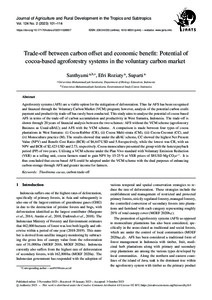Datum
2023-11-02Schlagwort
630 Landwirtschaft, Veterinärmedizin IndonesienKakaoproduktionAgroforstwirtschaftKakaobaumKohlendioxidFinanzanalyseMetadata
Zur Langanzeige
Aufsatz

Trade-off between carbon offset and economic benefit: Potential of cocoa-based agroforestry system implemented in voluntary carbon market
Zusammenfassung
Agroforestry systems (AFS) are a viable option for the mitigation of deforestation. Thus far AFS has been recognized and financed through the Voluntary Carbon Market (VCM) program; however, analysis of the potential carbon credit payment and productivity trade-off has rarely been conducted. This study aims to analyse the potential of cocoa-based AFS in terms of the trade-off of carbon accumulation and productivity in West Sumatra, Indonesia. The trade-off is shown through 20 years of financial analysis between the two schemes: AFS without the VCM scheme (agroforestry Business as Usual-aBAU); and AFS with the VCM scheme. A comparison is made between four types of cocoa plantations in West Sumatra: (i) Cocoa-Rubber (CR), (ii) Cocoa Multi-strata (CM), (iii) Cocoa-Coconut (CC), and (iv) Monoculture practice (M). The results showed that under the aBAU scheme, CC showed the highest Net Present Value (NPV) and Benefit Cost Ratio (BCR) of $6,647 USD and 5.8 respectively, while the lowest was CR, with an NPV and BCR of $2,423 USD and 2.73, respectively. Cocoa monoculture presented the group with the fastest payback period (PP) of two years. Utilising a VCM scheme under the Plan Vivo standard with Voluntary Emission Reduction (VER) as a selling unit, cocoa farmers stand to gain NPV by 15-25% at VER prices of $8 USD MgCO2e-1. It is thus concluded that cocoa-based AFS could be adopted under the VCM scheme with the dual purposes of enhancing carbon-storage through AFS and greater income for farmers.
Zitierform
In: Journal of Agriculture and Rural Development in the Tropics and Subtropics (JARTS) Vol. 124 / No. 2 (2023-11-02) , S. 101-114 ; eissn:2363-6033Sammlung(en)
Vol 124, No 2 (2023) (Journal of Agriculture and Rural Development in the Tropics and Subtropics (JARTS))Zitieren
@article{doi:10.17170/kobra-202311028937,
author={Santhyami and Roziaty, Efri and Suparti},
title={Trade-off between carbon offset and economic benefit: Potential of cocoa-based agroforestry system implemented in voluntary carbon market},
journal={Journal of Agriculture and Rural Development in the Tropics and Subtropics (JARTS)},
year={2023}
}
0500 Oax
0501 Text $btxt$2rdacontent
0502 Computermedien $bc$2rdacarrier
1100 2023$n2023
1500 1/eng
2050 ##0##http://hdl.handle.net/123456789/15157
3000 Santhyami
3010 Roziaty, Efri
3010 Suparti
4000 Trade-off between carbon offset and economic benefit: Potential of cocoa-based agroforestry system implemented in voluntary carbon market / Santhyami
4030
4060 Online-Ressource
4085 ##0##=u http://nbn-resolving.de/http://hdl.handle.net/123456789/15157=x R
4204 \$dAufsatz
4170
5550 {{Indonesien}}
5550 {{Kakaoproduktion}}
5550 {{Agroforstwirtschaft}}
5550 {{Kakaobaum}}
5550 {{Kohlendioxid}}
5550 {{Finanzanalyse}}
7136 ##0##http://hdl.handle.net/123456789/15157
<resource xsi:schemaLocation="http://datacite.org/schema/kernel-2.2 http://schema.datacite.org/meta/kernel-2.2/metadata.xsd"> 2023-11-06T14:45:14Z 2023-11-06T14:45:14Z 2023-11-02 doi:10.17170/kobra-202311028937 http://hdl.handle.net/123456789/15157 eng Namensnennung 4.0 International http://creativecommons.org/licenses/by/4.0/ cocoa-based AFS carbon trade-off theobroma cacao 630 Trade-off between carbon offset and economic benefit: Potential of cocoa-based agroforestry system implemented in voluntary carbon market Aufsatz Agroforestry systems (AFS) are a viable option for the mitigation of deforestation. Thus far AFS has been recognized and financed through the Voluntary Carbon Market (VCM) program; however, analysis of the potential carbon credit payment and productivity trade-off has rarely been conducted. This study aims to analyse the potential of cocoa-based AFS in terms of the trade-off of carbon accumulation and productivity in West Sumatra, Indonesia. The trade-off is shown through 20 years of financial analysis between the two schemes: AFS without the VCM scheme (agroforestry Business as Usual-aBAU); and AFS with the VCM scheme. A comparison is made between four types of cocoa plantations in West Sumatra: (i) Cocoa-Rubber (CR), (ii) Cocoa Multi-strata (CM), (iii) Cocoa-Coconut (CC), and (iv) Monoculture practice (M). The results showed that under the aBAU scheme, CC showed the highest Net Present Value (NPV) and Benefit Cost Ratio (BCR) of $6,647 USD and 5.8 respectively, while the lowest was CR, with an NPV and BCR of $2,423 USD and 2.73, respectively. Cocoa monoculture presented the group with the fastest payback period (PP) of two years. Utilising a VCM scheme under the Plan Vivo standard with Voluntary Emission Reduction (VER) as a selling unit, cocoa farmers stand to gain NPV by 15-25% at VER prices of $8 USD MgCO2e-1. It is thus concluded that cocoa-based AFS could be adopted under the VCM scheme with the dual purposes of enhancing carbon-storage through AFS and greater income for farmers. open access Santhyami Roziaty, Efri Suparti Indonesien Kakaoproduktion Agroforstwirtschaft Kakaobaum Kohlendioxid Finanzanalyse publishedVersion eissn:2363-6033 No. 2 Journal of Agriculture and Rural Development in the Tropics and Subtropics (JARTS) 101-114 Vol. 124 false </resource>
Die folgenden Lizenzbestimmungen sind mit dieser Ressource verbunden:


